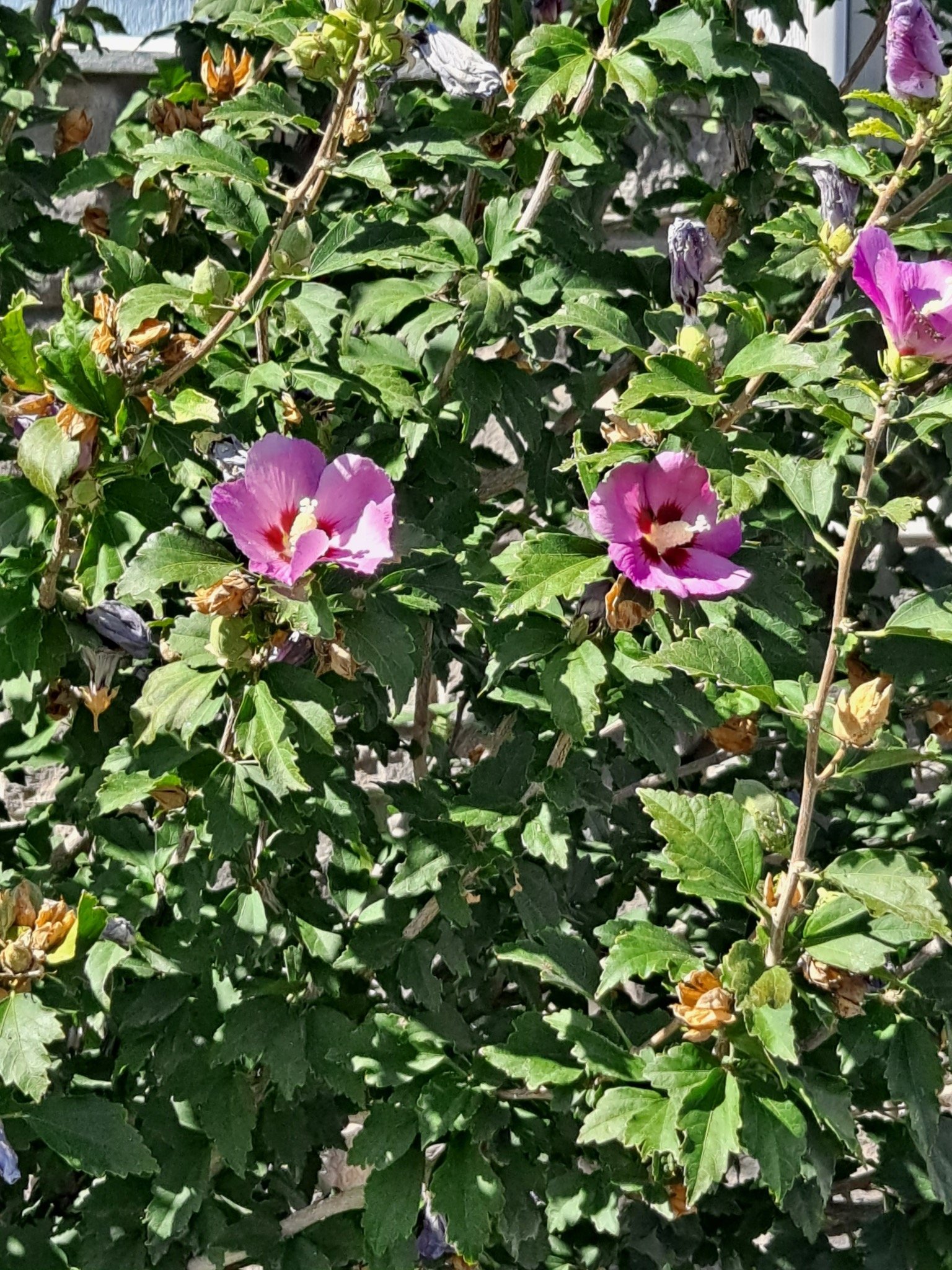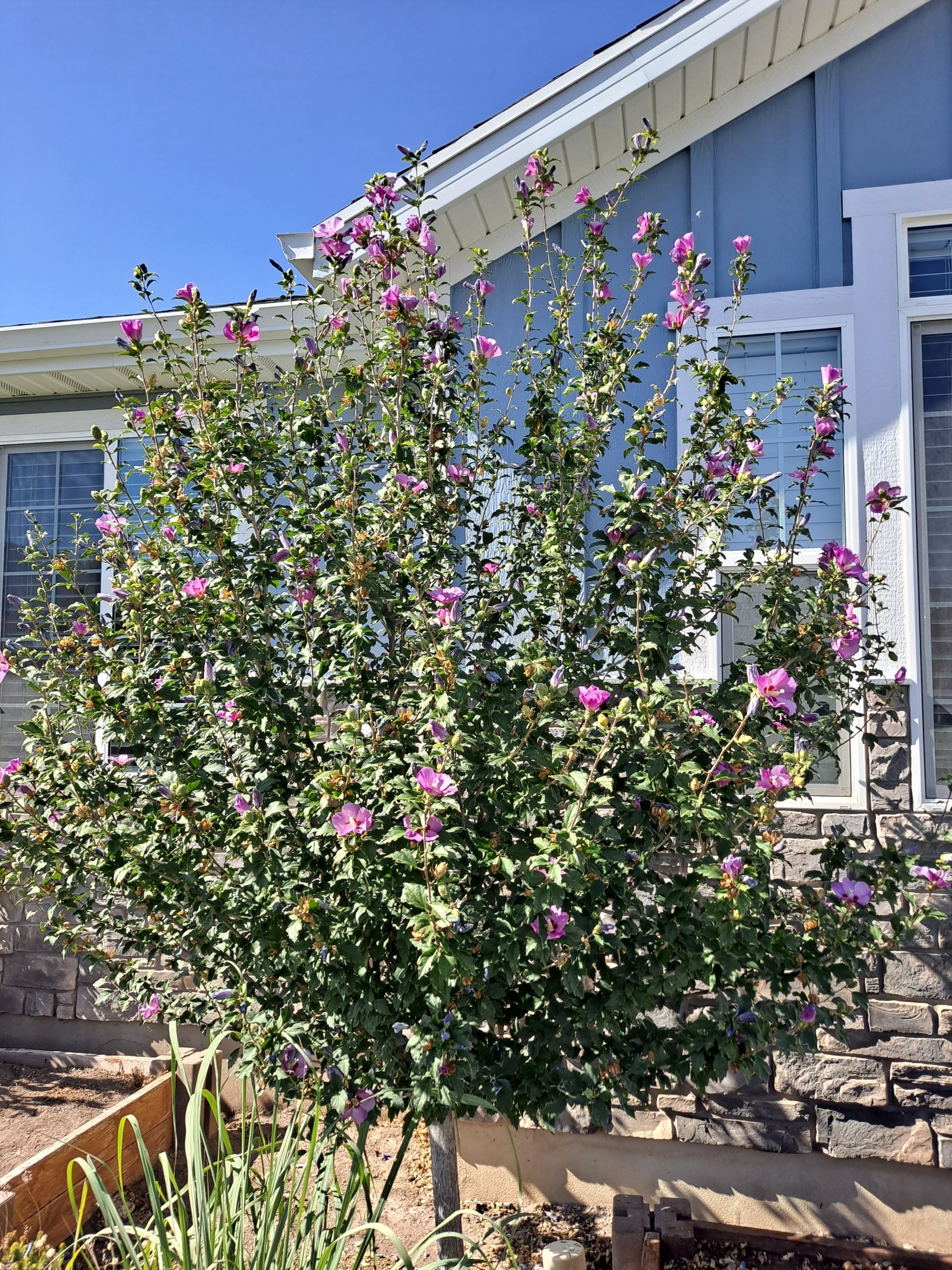The Story of Hibiscus syriacus: Origin, Growth, and Garden Wonders
Hibiscus syriacus, commonly known as Rose of Sharon, is an iconic flowering shrub that brightens gardens with its vibrant summer blooms. Its striking flowers and hardy nature have earned it a beloved spot in ornamental landscapes worldwide. In this post, we dive into this stunning plant's origin, range, and essential characteristics, giving you the information you need to grow it successfully.
Growth Habit: Shape, Height, and Width
Hibiscus syriacus grows as a deciduous shrub, often pruned and trained to take on a tree-like form. Its natural shape is upright and vase-like, branching out to create a pleasing, rounded canopy. This species can grow to 8 to 12 feet (2.5 to 3.5 meters) with a similar spread of about 6 to 10 feet (1.8 to 3 meters). Depending on the pruning practices, the Rose of Sharon can be cultivated as a dense shrub or a small multi-stemmed tree, making it highly versatile in landscape design.
Foliage: Deciduous Beauty
The foliage of Hibiscus syriacus is deciduous, meaning the leaves are shed annually in fall. The leaves are arranged alternately along the stems and are roughly three-lobed, resembling a simplistic maple leaf shape. Their color ranges from medium green in spring and summer to light yellow as they transition into fall. Each leaf is about 2 to 4 inches(5 to 10 cm) long, with serrated edges that add to its textural interest. The foliage provides an appealing backdrop to the stunning summer blooms.
Flowers, Seeds, and Fruits: Nature's Spectacle
One of the most alluring features of Hibiscus syriacus is its beautiful flowers. Blooming from mid-summer through early fall, the flowers are 5-petaled and resemble a trumpet shape characteristic of hibiscus plants. Each bloom measures 3 to 5 inches (7.5 to 12.5 cm) across, offering vibrant colors that range from white and pink to lavender and deep red. Many varieties have a contrasting darker center, adding extra visual drama. The single-bloom varieties are common, but semi-double and double forms are also available.
The flowers are stunning and pollinator-friendly, attracting bees, butterflies, and hummingbirds, making them ideal for supporting local wildlife. Once the flowers fade, they give way to capsule-like fruits containing multiple small brown seeds. These seed capsules persist into winter, offering visual interest and a source of food for birds in colder months.
Hibiscus syriacus 'Aphrodite'
Popular Varieties: Unique Features
Hibiscus syriacus comes in various cultivars, each with unique characteristics that set them apart. Here are some popular varieties:
'Aphrodite': Known for its large, single, soft pink blooms with a dark red center. It is among the most popular varieties due to its striking contrast and prolific blooming.
'Diana': A white-flowered variety with a unique trait—its blooms stay open at night, making it an excellent choice for evening gardens.
'Blue Bird' ('Oiseau Bleu'): Features lavender-blue flowers with a deep red throat. This variety is loved for its unique and rare blue hue, which adds a cool color palette to the landscape.
'Red Heart': Offers pure white flowers with a vivid red center, creating a bold and dramatic look. It is a favorite for gardeners seeking a high-contrast appearance.
'Sugar Tip': Notable for its variegated foliage, this cultivar has creamy white-edged leaves and double pink blooms, adding interest even when not in flower.
'Lavender Chiffon' produces semi-double lavender flowers with a lacy appearance, giving the garden a soft and romantic touch.
'Minerva': Displays lavender-pink blooms with a prominent red eye. It is a sturdy, easy-to-grow variety with great flower production.
Native Range: Where It All Began
The native range of Hibiscus syriacus extends from eastern China to India and Korea, where it has thrived for centuries in temperate climates. This plant has cultural significance in various Asian countries, notably South Korea, where it is regarded as a national symbol of resilience and beauty. Despite its origins in East Asia, the Rose of Sharon has found its way into gardens worldwide, particularly in Europe and North America, due to its adaptability and beauty.
Hardiness Zones: Where Can It Grow?
Hibiscus syriacus is well-suited to USDA Hardiness Zones 5 to 9. It tolerates various temperatures, surviving both cold winters and hot summers. In Zone 5, it may die back to the ground in severe winters, but it typically regrows vigorously in spring. Its hardiness suits most parts of the United States, especially in regions with distinct seasonal changes.
Sun Exposure: Soak in the Sun
For the best growth and bloom production, Hibiscus syriacus requires full sun exposure. It performs optimally with at least 6 hours of direct sunlight per day. Although it can tolerate partial shade, its flower production may be significantly reduced in lower light conditions. Adequate sun exposure is crucial for vigorous growth, maximum flowering, and an overall healthy plant.
Landscape Use: A Garden Favorite
Hibiscus syriacus is a versatile plant used in many ways within a landscape. Here are some of its most popular uses:
Specimen Plant: Its upright form and stunning flowers make it an excellent focal point in any garden.
Hedges and Privacy Screens: Planted in groups, they create dense hedges that provide privacy and beautify property lines.
Mixed Borders: It pairs well with perennials and other shrubs to add height and late-season color to garden beds.
Container Planting: Smaller varieties can also be grown in large containers, bringing color to patios and decks.
With its wide range of possible uses, Rose of Sharon can easily be used in both formal and informal garden settings.
Disease and Pest Resistance: A Resilient Choice
One of the great features of Hibiscus syriacus is its resilience to the most common pests and diseases. It is generally free from severe infestations, although occasional issues may arise. Aphids can be a problem during the growing season, but they are usually managed by natural predators or treated with insecticidal soap if necessary. Japanese beetles may also feed on the flowers, but they rarely cause significant harm to the plant's overall health.
Regarding disease, Hibiscus syriacus can be susceptible to leaf spot or rust in conditions of prolonged humidity. Ensuring proper airflow around the plant by avoiding overcrowding helps reduce fungal issues. Additionally, Rose of Sharon has a high tolerance for urban pollution, making it suitable for city gardens and roadside plantings.
Why You Should Add Hibiscus syriacus to Your Garden:
The Rose of Sharon is an exceptional shrub that combines resilience, visual appeal, and versatility in one package. Whether you're looking for a striking specimen plant, an effective privacy screen, or a splash of vibrant color in late summer, Hibiscus syriacus is a fantastic choice. Its beautiful flowers attract pollinators, its hardy nature makes it low maintenance, and its adaptability means it thrives in various garden settings.
To learn more about this lovely plant or others suited to your climate, check out trusted horticulture resources such as the Missouri Botanical Garden or the Royal Horticultural Society.
If you enjoyed this post and found it helpful, consider subscribing to our newsletter for more tips on choosing the right plants for your garden. And don't forget to share this article with fellow gardeners interested in adding Hibiscus syriacus to their landscapes!


